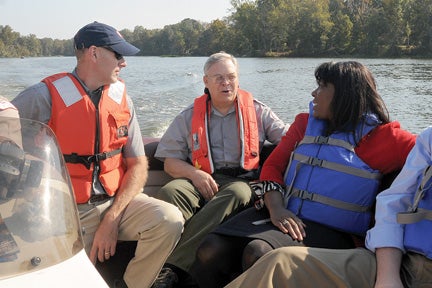Sewell’s visit touches on locks, river dredging
Published 11:38 am Thursday, October 18, 2012

U.S. Rep. Terri Sewell, right, took a tour of the Alabama River and locks and dams Friday afternoon with representatives from the U.S. Corps of Engineers.
By Katie Wood
The Selma Times-Journal
Many residents along the Alabama River spoke out against the U.S. Army Corps of Engineers plan that was originally slated to restrict recreational traffic and permit commercial traffic by appointment only through the locks and dams, and Alabama’s congressional delegation took notice.
The Corps unveiled their revised plan for the locks on the Alabama River on Oct. 10, and states the locks will be manned 10 hours per day, four days per week. Commercial boaters will be allowed to lock through 24 hours per day, seven days per week by scheduling an appointment. Recreational traffic can lock through in conjunction with maintenance operations. These changes will go into effect Feb. 1, 2013.
Because of the uproar prior to the release of the Corps’ new plan, U.S. Rep. Terri Sewell arranged a meeting with the Corps to learn more about the Alabama River’s lockage system and dredging challenges and tour a portion of the river Friday.
“First of all, how did we get here,” Sewell asked Corps representatives at the Alabama River Lakes Office in Lowndes County. “No one in our office even knew that you were considering closing down recreational use, so it just came as a shock for most of the delegation that that happened.”
Sewell said while she understood the Corps doesn’t “have to report to us; it was a big [public relations] nightmare for you guys.”
Pat Robbins, a Corps public affairs officer from the Mobile District, agreed.
“The headquarters did a study, to look at locks and waterways to figure out, if we’re only going to get $5 million to $5.5 million a year, how do we make the best use of that. So we’ve got to start making some hard choices,” Robbins said. “We’ve got locks falling apart all over the country, and you can’t keep operating with Band-Aids.”
The savings under the new plan is currently a personal cost savings, Robbins said.
“The savings are expected to be about $500,000 a year. We are going from 10 lock operators down to four (on the Alabama River),” he said.
Dredging the Alabama River, said James Curry, assistant operations manager for the Mobile District, “would be roughly $4.5 million. It varies on the severity of the shoaling.”
The Alabama River system needs to be dredged in order to maintain reliable navigability. The Alabama River was last dredged in 2010.
“We used a combination of some supplemental funding and stimulus funding to dredge in 2010, so we did not dredge in 2011 or 2012,” Curry said. “And there’s no money to dredge in 2013.”
While there are no funds currently available for dredging, maintenance operations on the locks will still be performed regularly.
“We get silt in our locks, so they have to be opened and closed periodically to remove that silt and debris and other stuff through there,” Robbins said. “So our plan is, on the days that we’re going to be open if a [recreational] boat is there when we’re doing a maintenance lockage, or for some other purpose, we’re going to be able to open and close those gates.”
“You can understand why the uproar was (over) a lack of knowledge and communication and public understanding of the fiscal concerns — we all know that we have to tighten our belts,” Sewell said. “The people, especially the folks I represent, are very sensitive about the Alabama River, because we know the great economic potential it could have for us.”
Once the Corps answered Sewell’s questions on dredging, the current plan for the locks and what events led to this point, her fact-finding mission lead her to a boat tour on the Alabama River.
Corps representatives took Sewell, and representatives from the Delta Regional Authority, on a tour through the Robert F. Henry lock that ended at the Selma Marina.
“I wanted to have an opportunity to see first hand the lock system so that I can better serve the constituents that I represent. I learned a lot today. I learned what the new plan is going to be and how it’s going to affect the residents of the 7th District and the counties I represent,” Sewell said. “And I learned a lot about the Corps today, and obviously about what they do. I think that will put us in good standing in dealing with the river.”
“I think it was very educational for everybody,” Robbins said. “I think everybody enjoyed it, and everybody got a really good picture of what the river’s like and what it’s like to go through a lock.”
Sewell gained a wealth of knowledge on understanding and approaching the issues concerning the Alabama River, she said.
“I know that if we dredge it, if we build it, people will come. People will come, industry will come, so anything that impacts this river, impacts the economic development of this region and therefore is an important issue for us to keep the pressure on,” she said. “Where we go from here is continue to try to press forward and making sure that the Alabama River remains a viable option for our economic development.”





